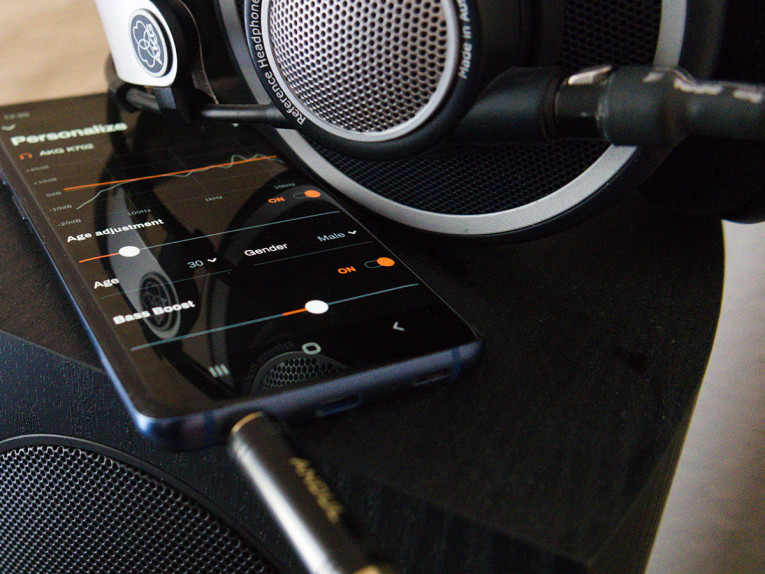
However, headphones can bring a few drawbacks of their own. One of which, certainly, can be the frequency response. As difficult as it is to find a pair of near-flat speakers, it’s even harder to find flat headphones. If you’re a headphone listener, you probably have a pair or two of cans that generally reflect your listening preferences. But undoubtedly, they still produce more or less bass than you’d prefer; more or less brilliance; and vocals and instruments aren’t cast in the same pristine light as from excellent speakers in a well-treated room.
The Software Solution
I’ve spent the last few weeks with True-Fi by Sonarworks, a software application working to counteract the frequency aberrations in your headphones (see Photo 1). And if you’re a headphone listener that’s yet to test drive True-Fi, I’m writing this for you. Sonarworks is a Latvian company that specializes in tuning up recording studios, purportedly 30,000 worldwide.
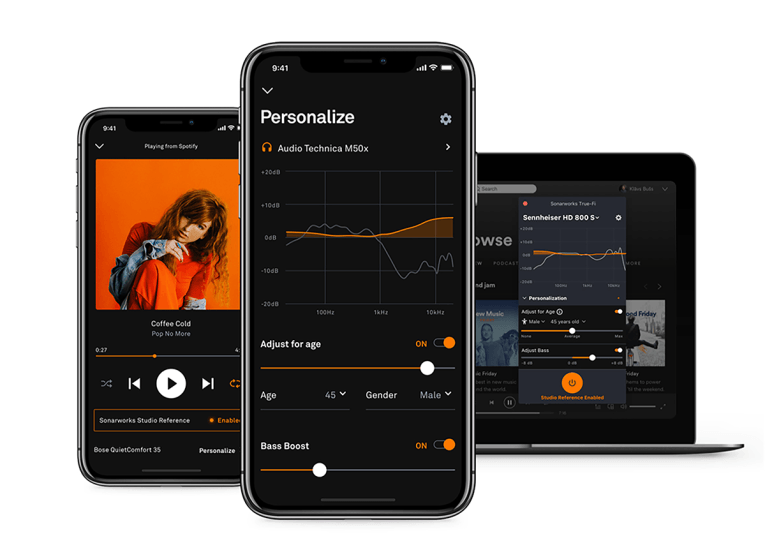
I interviewed Helmuts Bems, CEO and co-founder of Sonarworks, who filled me in on the story and direction of the company. “Sonarworks started off in 2012 when two music lovers — Helmuts Bems and Martins Popelis — met scientist Kaspars Sprogis: the perfect storm of acoustic know-how and passion for good sound became the software that’s currently transforming sound monitoring. The problem back then: all studios sounded different. The idea was to get free from unwanted coloration and to be consistent across rooms, devices, and users.” Bems summarized that Sonarworks has its roots in the studio, but today is correcting and personalizing sound for consumer headphone listeners as well. And in the future, Sonarworks intends to be the “ultimate sound experience on any device.”
True-Fi is Sonarworks’ consumer- and audiophile-oriented software. In 2017, Sonarworks launched True-Fi on the desktop for Windows and MacOS. The road to mobile support was inevitable, and Sonarworks began Android and iOS development early in 2018. As of this writing, mobile True-Fi is in early-access, expected for a full release in the second half of 2019. A permanent desktop/mobile True-Fi license can be purchased for $79 and can be activated on three devices, and Sonarworks intends to sell True-Fi in the Google and Apple app stores at $99 for lifetime access, or $3.99/month.

The Functionality
True-Fi has a petite interface with few functions. The primary purpose is to select your headphones and correct for them. Adding headphones is easy with its search bar and list of models sorted by brand (see Photo 2). When your headphone is loaded, the frequency response of your headphone is displayed in a graph. Clicking the power button at the bottom of the interface activates True-Fi, applying the frequency correction curve to the sound you hear. It’s immediate and can be toggled on and off to hear the difference (see Photo 3).
The interface also includes a Personalization section useful for counteracting age-related hearing loss and dialing in the amount of low-end to your taste (see Photo 4). Low-end is controlled by a slider from -8 to +8 dB. The high-frequency boost is applied a little differently. You select your age and gender, and the software applies a series of high-frequency shelves, which can be tamed with a slider from 100% down to 0%, with a default at 25%. Raising your selected age increases the effect. Set to female, the software boosts the treble to a lesser degree and beginning at higher frequencies relative to males.

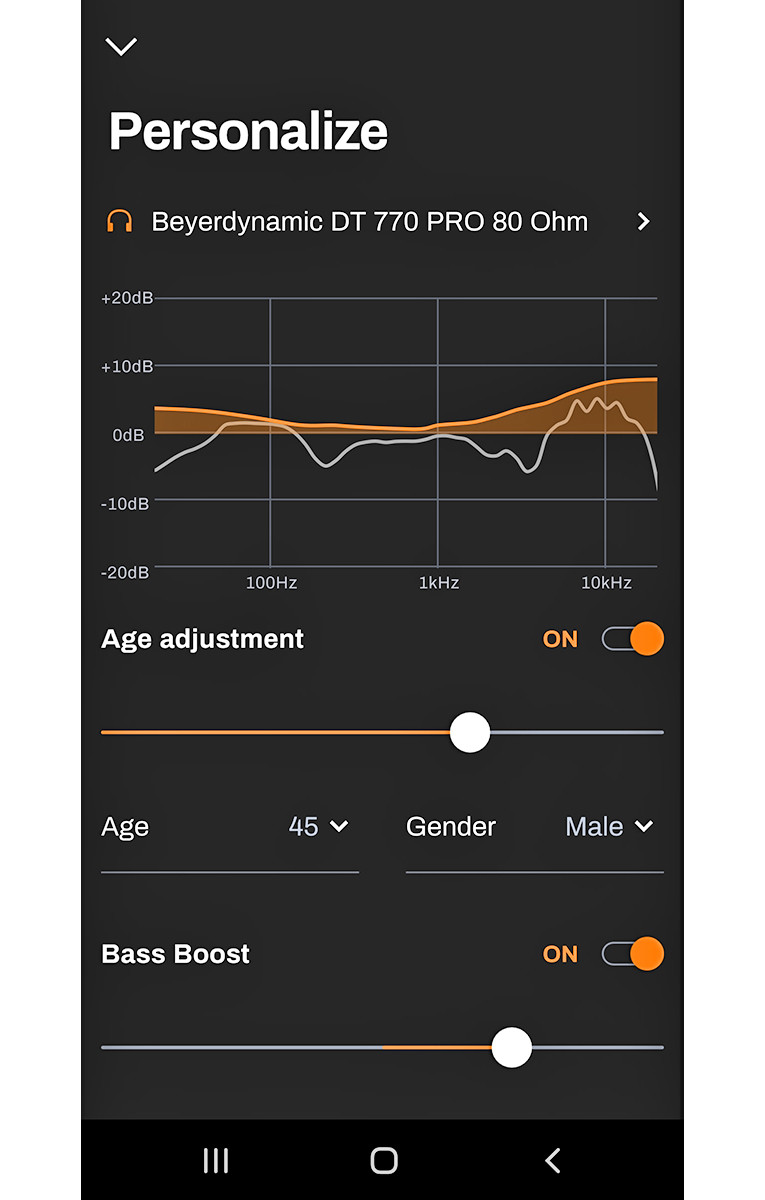
Support for your headphone model means that Sonarworks tested several different pairs of that same model and averaged the resulting curves to be able to correct your headphones with reasonable accuracy without ever measuring them directly. But if that’s not precise enough, you can buy headphones that have been directly measured from the Sonarworks store, or pay $149 plus shipping to have Sonarworks directly measure the headphones you already own.
Bems clarified, “No two headphones of the same model are made identical. Usually, the more expensive ones tend to be more consistent, but that’s not always the case. We try to cover as [many different headphone models] as possible and still maintain our quality standards. [But] there are some models that we don’t support due to [the] inconsistency being too great.”
OS Support
True-Fi makes for a breezy experience on the desktop. The installation is quick, the minimal interface is easy to understand, and system-wide support means that all sounds from all applications are corrected for. The only trick is remembering to disable True-Fi when switching from headphones back to speakers.
Sonarworks was right to see the limitations of a desktop app as most consumers also listen on-the-go from a smartphone. However, smartphone app development brings new challenges. For some devices, sample rates remain limited, but Sonarworks is on the case. “We have plans on supporting all sample rates relevant to music, from 44.1 kHz all the way up to 192 kHz. Platform support of these sample rates varies, and we are constantly working on improving support,” said Bems.
Another challenge is that, at the time of this writing, True-Fi on Android is limited to local files played directly through True-Fi as a media player, and Spotify streaming, not system-wide audio (see Photo 5). Bems informed me that “working with the limitations of creating a mobile application, we are planning on supporting additional streaming services and applications. While we keep building the application itself, we are also interested in offering deeper integrations with mobile phone and chipset manufacturers so that our technology becomes available on a system-wide level. This, in contrast, takes more time, so in the near future, we hope that additional streaming services will be welcomed by the community.”

Hearing the Difference
I listened on four pairs of over-the-ear headphones, and in all cases, the sound is better with True-Fi enabled. The correction is immediate and generally satisfying. Of course, the difference you hear will depend on the headphones you use, since every model of every brand of headphone will have a different frequency response, requiring different correction (see Photo 6).
However, across the headphones I tested, three pairs came with a natural upper-bass bloom around 150 Hz without much low-end to speak of below 80 Hz. Applying the correction gives kick drums and low bass notes clean emphasis and power that’s reminiscent of a solid system with good subs. In all cases, voices sound more centered and real, as heard from high-end speakers. Instruments sound truer and more hi-fi with the midrange brought into alignment. And invariably, cymbals just sound different, as though a different engineer mixed them. Looking at the frequency curves of my pairs of headphones in True-Fi, I can see how flawed the high-frequency response is in all four cases: correcting these flaws changes the frequency of sparkle in a song’s cymbals, which I find interesting to key into while toggling True-Fi on and off.
How much better does it sound? Sonarworks shipped me the Sony MDR-V150, a small pair of headphones currently $24 on Amazon. Enabling True-Fi with these creates a blinding difference of clarity, warmth, and depth. It’s truly startling, even for non-sophisticated listeners.
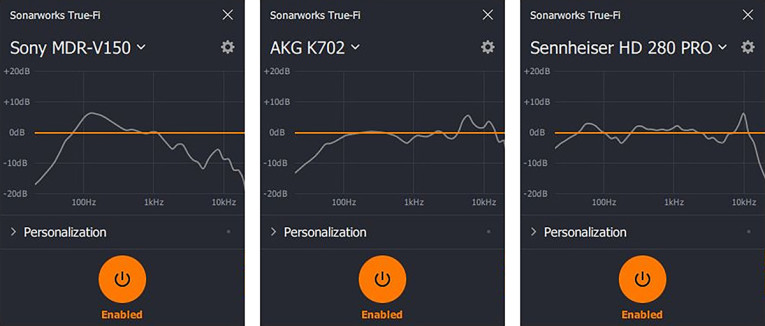
My favorite cans at home are the AKG K702s, now a relatively affordable $200 on Amazon. The difference here is more subtle, as the headphones already sound sweet and quite nice. But their brilliant clarity isn’t reduced as the mids are brought into balance and sub-bass is enhanced enough to be heard. I certainly appreciate True-Fi enabled versus without.
I listened with the personalization features turned off for most of my analysis, to hear the frequency correction for what it is without unfairly skewing the differences with additional low- and high-frequency boosts. Fair comparisons aside, I personally enjoy the age-related high-frequency boost around 15% to 20% engaged, and I find a 2 dB boost to the lows to sound quite pleasing.
Consumer vs. Pro
Above the $79 desktop/mobile price for True-Fi, Sonarworks’ desktop-only Reference 4 is priced at $99 for the Headphone Edition, $249 for the Studio Edition that can also correct for speakers with the help of a measurement mic, $299 for the Studio Edition to include a measurement mic, and $699 for the Studio Edition with a mic and also a pair of directly-measured Sennheiser HD 650 headphones. All flavors of Reference come with additional information and customization beyond True-Fi, and a defining feature for professionals is the ability to load Reference into a digital audio workstation in order to hear the correction while mixing or mastering.
“An ongoing challenge has been, for one, to deliver a subset of capabilities of Reference in a much more user-friendly way,” Bems said. “This required changing the approach we took: while being used to professional users that need to have detailed feedback about what is happening to their sound, the focus of True-Fi was to hide those details and to make it easy to adjust the most impactful settings.”
And the True-Fi development team certainly succeeded (see Photo 7). Sonarworks Reference contains a lot more graphed detail to take in, including Correction (the inverse of your headphones’ frequency response), Limits (designed to protect drivers from low-frequency excursion), Simulated After (an estimation of frequency response after equalization), Accuracy (margin of error when using averaged headphone results), and Phase (with large differences between the Linear Phase and Zero Latency modes).
Reference 4 also has customization features beyond True-Fi, including Tilt, a function that slants the target frequency response up to +3 dB at 20 Hz and -3 dB at 20 kHz, or in reverse, brightening the sound as it leans out the bass. The interface also includes the Bruel & Kjaer 1974 hi-fi frequency curve, and the X-Curve, a recommended frequency response for movie theaters. Also present are pre- and post-loudness meters, automatic and manual input volume attenuation to avoid clipping, a toggle for mono listening, and a Dry/Wet knob to dial in the strength of the correction.
I like seeing the many graphs of Reference and tinkering with the different curves, but truthfully, one can get very close to the desired sound with True-Fi’s frequency correction and its controls to adjust for bass preference and age.
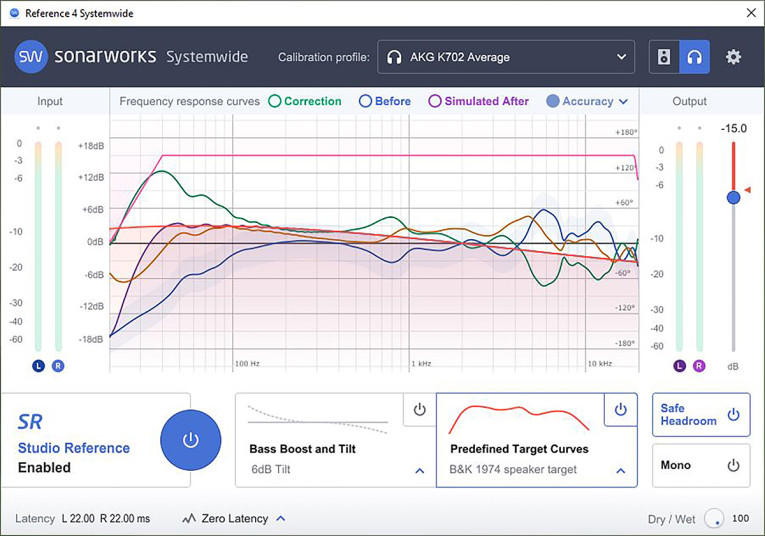
Shifting Toward Consumers
As pleasing as it is to have 80% of my over-ear headphones accounted for with True-Fi correction, only 20% of my in-ear headphones are currently supported by True-Fi: both of these pairs were stock Samsung earbuds that came bundled with my various smartphones over the years (see Photo 8). In both of these cases, True-Fi radically alters the sound, but it isn’t so much improved as it is differently — yet equally-bad.
There are two immediate problems here: the first is that, at present, consumers are unlikely to find the headphones they already own to be supported by True-Fi. Bems acknowledged this gap: “Up until now, we have been geared toward serving music studios and engineers, and as such, providing profiles for the headphones they typically use. These are radically different than the headphones most listeners will be using, so we’re [now] paying more attention to the other side of the equation and have a roadmap of headphones and in-ears in wider use among most music listeners.”
Fortunately, Sonarworks has a history of continuing to add new headphone models to its database, and the models added are chosen with intention. “We take into account particular model requests from our existing and potential clients, headphone bestsellers in the biggest online stores, [and] popular headphones among different audiences,” Bems added. Sonarworks has a complete list of supported headphones on its website, which I recommend investigating before purchasing True-Fi.
The second problem is the ineffectiveness of True-Fi on my two models of Samsung in-ears. I shared my experience with Bems, who said, “We’ve seen substantial differences in frequency response between the same model in-ear headphones that come bundled with a phone. These kinds of headphones make up a significant part of the whole market, so we try to cover as much as possible and still maintain our quality standards.“
But there’s more to the story than unit-to-unit variance and invisible design refreshes across the cheapest and highest shipping in-ear headphones. Bems added, “The calibration effect usually is more drastic for in-ear headphones than over-ear headphones, as the curves tend to be more extreme: therefore, [True-Fi] sometimes makes massive cuts or boosts. In-ear headphone frequency response is dependent on the listener’s physical properties, and [a poor] seal can lead to diminished calibration accuracy. Also, we’ve encountered knock-offs of popular in-ear headphones that are visually indistinguishable from the real thing but have very different frequency response: obviously, our calibration isn’t accurate in such cases.”
The Technical Side
Astute readers might wonder what happens when you boost EQ to signals potentially as loud as 0 dB full-scale. Upon installing the desktop version of True-Fi and enabling it, the software displayed a message that the audio was clipping and gave instructions to pad the volume inside True-Fi, providing headroom for EQ boosts. The problem was easily identified and easily fixed.
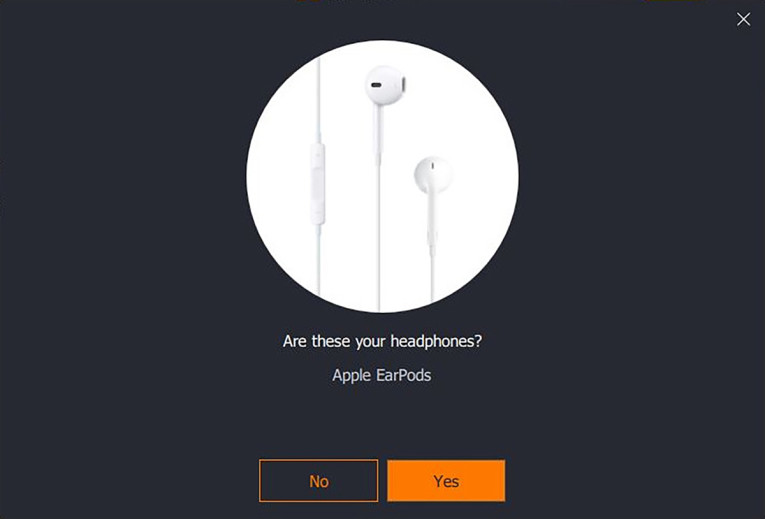
The Future of Sonarworks
Beyond adding calibration curves for many more headphone models, Bems offered me a glimpse into the future of Sonarworks: I asked if Sonarworks will ever support phase correction, and Bems said that his team is considering it for the future. He also shared, “We have some exciting new features in the works that should greatly improve users’ listening experiences.
Some will assist people in finding a target curve they like better without delving into details of audio or equalization themselves. Others are focused on hearing correction tailored for each specific listener.” And perhaps more exciting for those who enjoy a good set of speakers, Bems suggested that Sonarworks is coming to the living room. Whether this would come in the form of integration into receivers or a standalone device, he didn’t specify. He said that we could expect this “most probably [in] 2020, but we can’t promise exact timing.”

Conclusion
When it comes to desktop listening, I’ve rapidly become a contented True-Fi user: it simply makes my headphones sound better. I wouldn’t go so far to say that it makes all headphones sound the same — a claim I have heard tossed about. I can still hear more detail and liveliness on my best headphones, and my worst headphones are still a bit fatiguing due to their higher distortion. But even so, each pair sounds better with True-Fi than without.
For mildly enthusiastic headphone listeners, $79 may be a steep price, but such users are likely to listen through headphones that could benefit tremendously. And for those listening on nicer pricier cans, the value proposition makes even more sense relative to the cost of other upgrades.
As we’ve discussed, Sonarworks is shifting its focus to include audiophiles and consumers, and of course, that means many additional headphones for which to develop calibration curves. This will be the first of Sonarworks’ growing pains. And there’s still a lot of room for development for mobile listeners: The tech is solid and sounds great, but the support just isn’t there yet. I look forward to Sonarworks integrating with more of my favorite apps and streaming services, but for true ease-of-use, Sonarworks needs to bring system-wide True-Fi to the smartphone. I’m glad to hear that Sonarworks is connecting with smartphone makers and chipset makers for this to happen.
Bems said, “We’re targeting a very broad audience: everyone who loves music. We are trying to tackle a very general problem that underpins all music today. Our technology should be a game changer in how casual music listeners, artists’ fans, and audiophiles all listen to music, and can do so in the palm of their hands without spending a fortune on expensive equipment.”
For now, I recommend True-Fi to anyone who takes satisfaction in listening to headphones fed by a computer. Support from the right streaming service can likely make or break a mobile customer. And the future will be bright indeed when every phone and every living room has the potential to sound its best using Sonarworks equalization. aX
www.sonarworks.com
This article was originally published in audioXpress, July 2019.
About the Author
Luke McCready is an audio engineer, a technical writer, and a music lover based out of Boulder, CO. He graduated with a degree in audio engineering from North Central University with a passion for audio and a fascination for speaker setup and acoustic treatment.





